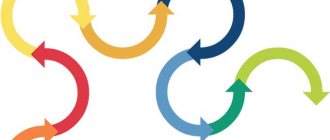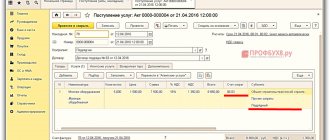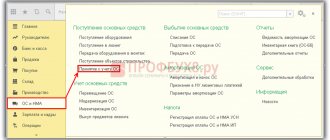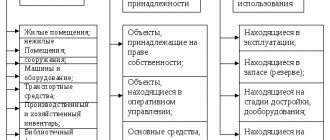Application of reduction factors
By decision of the head of the organization (institution), any fixed assets in tax accounting can be depreciated using reducing factors (i.e., in slow mode). Such a decision must be enshrined in the accounting policy for tax purposes. A reduction factor can only be applied from the beginning of a new tax period. In the future (in a year, two, etc.) the organization has the right to refuse reducing factors. This is also possible only from the beginning of the next tax period.
If you apply reducing factors, then when selling property, do not recalculate depreciation according to normal rates (that is, take into account the entire residual value of this fixed asset in expenses). This procedure is provided for in paragraph 2 of paragraph 4 of Article 259.3 of the Tax Code of the Russian Federation and is explained in the letter of the Ministry of Finance of Russia dated November 16, 2015 No. 03-03-06/4/65907.
Special coefficients when calculating depreciation
The materials were prepared by a group of methodological consultants
from JSC Intercom-Audit.
Increasing coefficients
In relation to fixed assets, taxpayers can apply special increasing and decreasing coefficients provided for by the Tax Code of the Russian Federation to the basic depreciation rate. In accordance with paragraph 7 of Article 259 of the Tax Code of the Russian Federation, increasing coefficients are provided in relation to:
— depreciable fixed assets used to work in aggressive environments and (or) extended shifts. In this case, the taxpayer has the right to apply a special coefficient, but not higher than 2. An aggressive environment is understood as a set of natural and (or) artificial factors, the influence of which causes increased wear (aging) of fixed assets during their operation. Also, working in an aggressive environment is considered to be the presence of fixed assets in contact with an explosive, fire-hazardous, toxic or other aggressive technological environment, which can serve as the cause (source) of initiating an emergency;
— depreciable fixed assets that are the subject of a financial lease agreement (leasing agreement). In this case, the taxpayer, whose fixed asset must be accounted for in accordance with the terms of the financial lease agreement (leasing agreement), has the right to apply a special coefficient to the basic depreciation rate, but not higher than 3. These provisions do not apply to fixed assets related to the first, the second and third depreciation groups, if depreciation for them is calculated using a non-linear method. Taxpayers who transferred (received) fixed assets that are the subject of a leasing agreement concluded before January 1, 2002, have the right to charge depreciation on this property using the methods and norms that existed at the time of its transfer (receipt), as well as using a special coefficient, but no higher than 3.
- taxpayers - agricultural organizations of industrial type (poultry farms, livestock farms, fur-bearing state farms, greenhouse plants), which, in relation to their own fixed assets, have the right to apply a special coefficient to the basic depreciation rate, chosen independently taking into account the provisions of the Tax Code of the Russian Federation, but not higher than 2.
Example.
In February 2003, the organization put into operation a fixed asset purchased in the same month for 240,000 rubles, including VAT - 40,000 rubles. This fixed asset belongs to the fourth depreciation group; upon acceptance for accounting, the organization established its useful life as 6 years (72 months). The main asset is used in the production process under conditions of increased shifts, which allows a special increasing factor of 1.4 to be applied to the main depreciation. The organization calculates depreciation using the straight-line method.
The monthly depreciation rate for this fixed asset, calculated based on the established useful life of the object and a special increasing factor, will be 1.94% ((1: 72 months) x 100% x 1.4).
The amount of monthly depreciation deductions taken into account when taxing profits will be equal to 3880 rubles. (RUB 200,000 x 1.94%: 100%).
Reduction factors
Accrual of depreciation at rates lower than those established by Article 259 of the Tax Code of the Russian Federation is allowed by decision of the head of the organization - the taxpayer, enshrined in the accounting policy of the organization, and only from the beginning of the tax period and throughout the entire tax period.
According to paragraph 9 of Article 259 of the Tax Code of the Russian Federation for cars and passenger minibuses, the original cost of which, respectively, is more than 300 and 400 thousand rubles, the basic depreciation rate is applied with a special coefficient of 0.5.
Example.
In January 2003, the organization put into operation a passenger minibus, the initial cost of which was 470,000 rubles. The minibus, in accordance with the Classification of fixed assets, belongs to the third depreciation group; when accepting the object for accounting, the organization established a useful life of 3.5 years (42 months). Depreciation for profit tax purposes is calculated using the straight-line method.
The monthly depreciation rate, taking into account the reduction factor, will be equal to 1.19% ((1: 42 months) x 100% x 0.5).
The amount of monthly depreciation deductions taken into account for profit tax purposes will be 5,593 rubles. (RUB 470,000 x 1.19%: 100%).
The amount of depreciation accrued during the useful life of the fixed asset will be equal to 234,906 rubles, while its original cost is 470,000 rubles.
From the above example it is clear that when using reducing factors and applying the linear depreciation method, the organization will not be able to completely write off the cost of a given fixed asset as production costs or selling expenses.
Clause 1 of Article 259 of the Tax Code of the Russian Federation provides that taxpayers using reduced depreciation rates do not recalculate the tax base by the amount of underaccrued depreciation against the norms provided for by the Tax Code of the Russian Federation for tax purposes.
A slightly different situation arises when taxpayers, when calculating depreciation, use a non-linear method of calculating depreciation: expenses can include a depreciation amount greater than when using the linear method.
Let's use the conditions of the previous example and calculate depreciation using the nonlinear method.
The depreciation rate, calculated based on the useful life and the reduction factor, will be 2.38% ((2: 42 months) x 100% x 0.5).
| Period | Calculation of depreciation amount | Residual value at the beginning of the next month |
| February 2003 | 470,000 rub. x 2.38% = 11,186 rubles. | 470,000 rub. – 11,186 rub. = 458,814 rub. |
| March 2002 | RUB 458,814 x 2.38% = RUB 10,919.77 | RUB 458,814 – 10,919.77 rub. = 447,894.23 rub. |
| April 2003 | RUB 447,894.23 x 2.38% = 10659.88 rub. | RUB 447,894.23 – 10,659.88 rub. = 437,828.47 rub. |
| … |
Having calculated the amount of depreciation charges over the entire useful life of the object, we obtain an amount equal to 299,105.43 rubles. When using the non-linear method, the organization will also not be able to write off the entire cost of the fixed asset. However, the amount of depreciation accrued when using this method is greater than the amount of depreciation accrued when using the straight-line method, it is equal to RUB 234,906.
The reduction factor is applied by organizations that have received or transferred cars and passenger minibuses on lease (clause 9 of Article 259 of the Tax Code of the Russian Federation). The specified property is included in the corresponding depreciation group and the basic depreciation rate is applied to this property, taking into account the special coefficient applied by the taxpayer for this type of property.
If the parties to the leasing agreement provide for the use of an increasing factor of no more than 3, then the coefficient applied to the basic depreciation rate will be calculated as the product of the established increasing factor by 0.5.
Separate accounting
If an organization (institution) calculates depreciation using a non-linear method, then fixed assets to which increasing (decreasing) coefficients are applied must be included in separate depreciation subgroups (clause 13 of Article 258 of the Tax Code of the Russian Federation). The fact is that with the non-linear method, depreciation is accrued not for each fixed asset, but for depreciation groups as a whole. Since increasing (decreasing) factors may not apply to all fixed assets included in the depreciation group, they must be taken into account separately. This is stated in paragraph 2 of subparagraph 1 of paragraph 1 of Article 259.3 of the Tax Code of the Russian Federation.
Aggressive environment and increased shifts
Such conditions may be present in the activities of various food industry enterprises.
However, there are certain difficulties with using a multiplying factor not higher than 2. Firstly, Federal Law 206-FZ dated November 29, 2012 limits the right to apply such an increasing coefficient until 2014 ( paragraph 5, paragraph 1, paragraph 1, article 259.3 of the Tax Code of the Russian Federation ), and we are talking specifically about the date of introduction of the operating system into operation ( Letter of the Ministry of Finance of the Russian Federation dated January 14, 2013 No. 03-03-05/1 ). Property that is included in the fixed assets until the specified time limit continues to be depreciated after that with an increasing factor if used in an aggressive environment and (or) increased shifts.
Secondly, for tax purposes there is a separate concept of an aggressive environment. To apply the increasing factor, the following conditions must be met:
– production technology implies the presence of an explosive, fire-hazardous, toxic or other environment in the production process;
– the main tool is in contact with this environment;
– this environment serves as the cause (source) of initiating an emergency situation.
The concept “in contact” means that a specific unit of fixed assets is in direct contact with an explosive, fire-hazardous, toxic and other aggressive technological environment. The Tax Code of the Russian Federation does not establish a list of documents necessary to confirm the legality of applying an increasing coefficient to the depreciation rate. In this regard, the fact of operation of fixed assets that are actually located in an aggressive environment or in contact with a fire hazardous environment can be confirmed by any evidence substantiating these circumstances. For example, work in an aggressive environment can be evidenced by an object passport, technical description and other documents that indicate the essential operating conditions of the OS. At the same time, in relation to each individual fixed asset item, specific factors (natural and (or) artificial) are established that cause increased wear and tear ( Letter of the Federal Tax Service of the Russian Federation dated July 1, 2013 No. ED-4-3 / [email protected] ).
Thirdly, in Art. 259.3 of the Tax Code of the Russian Federation there are no instructions regarding extended shifts. Therefore, organizations have to resolve their doubts in court. Among the landmark decisions of arbitrators, we highlight Resolution of the Supreme Arbitration Court of the Russian Federation dated November 20, 2012 No. 7221/12 . An increased shift of work of fixed assets (exceeding their two-shift operation) is a factor that influences the physical wear and tear of depreciable property, and depends on the intensity of use of labor tools. The Tax Classification of fixed assets contains the names of depreciable property, which corresponds to the All-Russian Classifier of Fixed Assets OK 013-94 . In order to eliminate uncertainty regarding the legality of applying the increasing factor, it should be assumed that accelerated depreciation of fixed assets due to their operation in extended shift mode does not apply only to machinery and equipment named in the section “Machinery and Equipment” OK 013-94 as OS for continuous production. Accountants in the food industry need to pay attention at this point to avoid losing the case in court.






